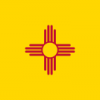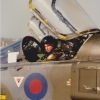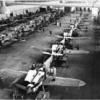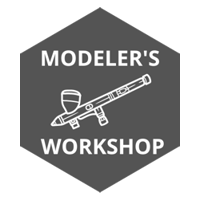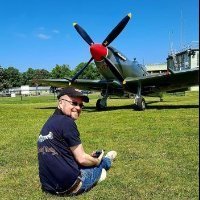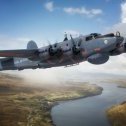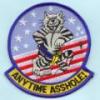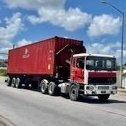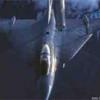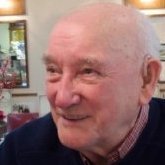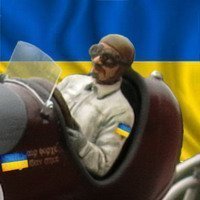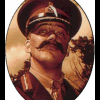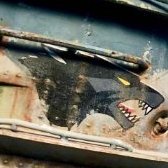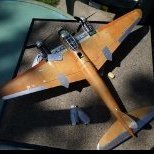Leaderboard
Popular Content
Showing content with the highest reputation on 29/05/23 in all areas
-
Hi everybody, this is my first aircraft completion of 2023 - A 1/72 Modelsvit Mirage IIIO built in the Marcel Bloch/Dassault Aviation Group Build. The build thread is here: The finish is Model Master Metalizer brushed/polished on - the details of the technique are in the build thread. As usual, it's difficult to capture how a metal finish looks in photos, so I tried to take these RFI photos in many varying lighting setups. I really enjoyed the Modelsvit kit and have their Mirage 2000-5 and Mirage 4000 in the stash, so I think I may just keep building them!45 points
-
Well, it has wings and the Hasegawa box says 1/72 scale. Wonderfest (a Sci-Fi show in Louisville, KY) is just around the corner and I hate to go empty handed. The influence of the FW 190 D is obvious, but Hasegawa kept hanging things on her. She looks decidedly crowded. The Hasegawa kit has some speculative German-type schemes but I decided to go original with the camo and markings. It was fun, but the build took some careful planning on the camouflage. Hope you enjoy!28 points
-
Nice little build in 1/72 vacform. Lots of injection molded parts too, particularly cockpit and main cabin details. I built it as a New Zealand example (rego ZK-NSN) operated by Air Nelson in the late 1990s and early 2000s Not too difficult to build for a vacform and comes up quite well. 1I7A8726 by Harry Follas, on Flickr 1I7A8743 by Harry Follas, on Flickr 1I7A8727 by Harry Follas, on Flickr 1I7A8735 by Harry Follas, on Flickr26 points
-
On a bank holiday weekend, definitely the latter; just one of the multitudinous chores to keep one away from the modellers bench So I diffidently present some minimal progress. We're off for a cycle ride along a section of the Leeds-Liverpool canal shortly so I'd better be brief.... Plans and photo's show that the rear of the enlarged Mk II-style radiator housing angled back towards the fuselage quite noticeably, so mine needed sanding to the correct angle. I usually make up a sanding jig from plastic card and self-adhesive sand paper to get a neat job. But It's just so much easier to use Fusion and the Printer for such tasks now. So one sanding jig was rapidly produced (it's way quicker to do the CAD than it is to measure, cut and glue the plastic card - and the printing time don't really count seeing as you're not really involved...) : And the rear of the radiator sanded to the correct profile: And the radiator housing was finished off by modifying the radiator flap cut-out and the radiator faces: I think a good coat of halfords filler-primer on the housing will be the next step, to show and hopefully fill, any little contour defects; and that'll be it done. The only other task i've had time for this weekend is to modify the shape of the trim tab on the rudder from the narrow version of the Mk I to the enlarged version of the Mk II/TT Mk I. A simple enough task of filling with sproo-goo and rescribing, but the sort of task I find annoyingly time consuming to achieve neatly. Anyways - that's probably the sum total of my bank holiday progress....24 points
-
When I started building this model, I wanted it to tell a story. About a machine piloted by allied pilots bravely fought on the front of WWII. About a plane that, despite having more than fulfilled its task in the skies of Great Britain defending it in the Battle of Britain, when it came time to give way to others, was not put back in the hangar. Instead of a well-deserved retirement, this machine returned to the aircraft factory where it got a new life. Like a phoenix from the ashes, Hurricane was reborn as Sea Hurricane. The carrier-based fighter was born. A difficult task was set before the rebuilt aircraft - to face the Regia Aeronautica and Luftwaffe aviation over, among others, the waters of the North Sea and the Mediterranean. The conditions in which these machines operated left their mark. Airplanes, like people, bore the scars and traces of quick repairs made on aircraft carriers by their crew. This is the Sea Hurricane I wanted to show. An aircraft with a rich history, on which a long service has left visible traces, nevertheless being a deadly weapon in the hands of an experienced pilot. The machine I chose was, in my opinion, uniquely suited to this story. This aircraft served, among others, in the Polish 317th squadron where it was damaged. After repairs, it was converted to a Sea Hurricane and assigned to the aircraft carrier HMS Eagle. Unfortunately, it sank with the torpedoed ship during Operation Pedestal on August 11, 1942. You can watch whole build process on Youtube:18 points
-
Airfix new tool Heinkel 111-P 1/72 converted to Battle of Britain movie Merlin engine CASA `Einkels`. Replaced the Jumo's with Airfix old tool Lancaster engines. Scratch built target winch, cable gear, engine surrounds, smoke generators and aerials. Added dome aerials from spares box. Crew modified Revel hard plastic Luftwaffe crew and green stuff. Rear canopy modified chopped kit parts. Painted with Humbrol enamels and pro modeller washes. Decals aftermarket. Yes, I got the stripes the wrong way (doh!) up but I like the finish so will live with it for now. "No, they're Einkels"15 points
-
Another one for my collection of 1/72 scale versions of warbirds that I've had the opportunity to sit in, either static on the ground or in the air. Latest is the Airfix P-51D "Contrary Mary", representing the TF-51D from Ultimate Warbird Flights I flew in earlier this month. Not a bad little kit, for just under £9. Had to buy two tho, as I massively messed up my first attempt at the blend of natural metal finish fuselage and painted silver wings, so the first got sacrificed as a test mule. I used Humbrol metalcote polished aluminium for the fuselage and some panels on the lower wings, burnished with a gentle action on my multitool, and good old Humbrol no.11 silver on the wings and tailplanes. Gloss finish to the wings, satin on the fuselage as its not that shiny on the real aircraft. Decals are Lifelike, which went on fairly well, even on the compound curves. Just the vertical tail ones split a little and needed some touching in. Only major fault on the kit is a huge amount of flash on the aerial, so I had to cobble together one from scrap. All in, it served as a nice warm up and practice for the 1/32 scale version I will build later this year.15 points
-
Morning all. That's the Introduction finished then. Chapter 1. Despite all that appearances might conspire to suggest, work has in fact continued on designs for the Wasp over the past months and weeks, though out of a range of circumstances, two quite specific modelling factors have impacted upon the rate of progress. The first of these factors stems directly from having received a couple of requests from individuals elsewhere on the web wanting to purchase copies of this kit in 1/24th scale (aside from a 1/32nd version already promised here), such an issue necessarily requiring some earlier design decisions relating to the tail and cabin areas be re-examined from the point if view of somebody else having to manageably build one. Secondly, there was also the non-trivial question of having to build the means to vacuum-cast aluminium parts. I'll come back to the latter process later - it makes more sense I think to report on how the work has changed chronologically in the interim. Some time back I'd planned on leaving the aircraft skin 'clean' of rivets here, said features being added later using Archer's rivets in emulation of @Ex-FAAWAFU's glorious Sea King fantasia of legend. This notion has been summarily sent to feed the dust. Although Archer's have ceased trading but with Quinta apparently stepping in with a far more affordable alternative set of rivet layouts, the anticipated complexity of these designs in final kit form (as well as the expense of someone having to buy that many rivets to add as aftermarket) didn't strike me as a fair bargain to the Wasp-hungry, so felt I felt obliged to add these to the airframe myself as part of the printed detailing. Sanity be damned. Only the tailcone and boom have received such treatment so far, to whit the results of several thousand purgatorially-produced rivets now visible along the flanks: The asymmetic arrangement of maintenance access panels (the preponderance of these being along the port side) rendered this a much more prolonged task than simply creating the rivet formations on one side of the aircraft and subsequently mirroring them across to the other: Quite how much of that will be visible under BlueGrey in all but the most oblique of lights only time and pigment will tell of course - here's the somewhat more straightforward starboard side by contrast: With a tailcone able to be open or shut: There is another<collective noun> of rivets arrayed on the opposing faces of those sections that again were delightfully non-identical enough to stop you just mirroring the patterns from one side to the other: With a rather intimidating number of parts already in the design library, it made sense to actually finish off the rear of the aircraft before procedding forward again to the Nimbus and engine deck (lest crucial details get overlooked) so I set to work on the tailplane and rotor. With these two features at right angles to each other back there, any errors in one would be magnified by the other, so having @Anthony in NZ's measurements of such features cross-referenced with leading particulars in the maintenance manual meant being able to lay out the required dimensions with confidence in advance of creating the parts themselves: Not of course forgetting to check that said windmill doesn't meet the bigger one at the front in an unholy shattering of rotor blades and dreams... Much like cleaning a child's face, one you start adding rivets to one bit, of course you have to do the rest: Conforming to that modelling maxim that 'from afar 'tis fair, in proximity, is far from', the tail rotor had a surprising number of complex shaping tasks required to get the hub and blade mounts right: In printing terms that will I think need to be produced as three seperate parts in order to avoid 'support-acne' bedevelling those nice smooth surfaces. To wrap up this section then, renders of the finished tail assembly: At the start of this update I mentioned the need to learn certain aspects of metal casting for this build. The two specific areas of the main rotor assembly requiring metal parts are outlined here: As you can see, the two weak points concerned are the forks where they actually grip the blades, and the pitch change arms (inverted 'C' shaped features attached to the rear of the blade extension and the arms of the spider arriving to meet it from below). For the combination of strength and lightness it had to be aluminium/aluminum ('the Transatlantic metal') used in this instance. All well and good of course but I had to learn to do lost wax casting to achieve this, and, as the expense of buying kilns and furnaces was out, that also meant I had to build the means to cast myself (along with the inevitable experimentation with materials which such processes always require). I won't belabour the details here (though if anyone would find it useful for me to post details over in the 'techniques' section I'm perfectly happy to bore you to tears at great length there 🤣) but after several weeks I had a working gas furnace recycled out an old Calor cylinder with its middle section removed to reduce it to the required interior volume for the kind of casting jobs I needed to do: Despite the Heath Robinson nature of the undertaking, 'Old Hades' here reliably gets to over 800°C - well in excess for what aluminium casting requires. Gravity-fed casting alone though proved incapable of getting molten metal down into the finer parts of the pattern so I additionally had to learn to use vacuum casting processes as well in order to force the metal in to the required extent. To do this a cheap pump/chamber combination sufficed, which I drilled out and added some new parts to so that it could function as both vacuum chamber (for the investment) and vacuum table (for the metal pour). The results of this marriage between hope and instinct payed-off with a blade extension and pitch arm of the required material strength for the job: The surfaces of that first fully-successful cast still suffered from some gas porosity as you can see above, however such experiences have proven invaluable in giving me the means to now produce such pieces in volume with a much higher surface quality when fresh out of the furnace: A light sand and a polish should bring those up to requirement in due course. That's it for this instalment. Thanks for reading as always - there's a lot more CAD work to show in relation to the Nimbus and engine deck where the fuel and oil systems are now almost complete and the hydraulics have been started on. Again I've made some changes to the engine detailing/structure to account for others having to build copies themselves, so more on that next time as well. Until then, Tony14 points
-
Not a clever shot, but it demonstrates how well it gives that flush glazed looked. It looks wet, but that resin is as hard as it gets. Lovely stuff.14 points
-
Here is my recently completed build of the Bisnovat SK-1 High Speed Research Aircraft using the Jet & Prop 1/72 resin kit. Built OOB and it built beautifully all the way through. The resin was nice and crisp with very little clean up required. The canopy is of clear resin, lovely. The kit masks were applied to the canopy before being painted overall with Tamiya AS-12. More masks applied before the red was applied. No decals. mounted on a simple base with a figure. Build log here: Alongside its contemparies, Heston Napier V on the left and the Me 209V1 on the right. Hope you like Stuart13 points
-
Here is my next 1/48 armor build. This is Bronco's KV-14 or Su-152 (edit: thanks @echen for setting me straight on that). This tank destroyer was the forerunner of the much better know ISU-122. The difference being that the ISU was based on the JS-2, while this was on the KV-1 suspension. Bronco's kit is very nice, and this model is built from the box. I wanted to represent a tank with a lot of dust from tank-rider foot traffic on the rear deck. Originally, this was to have some tank riders on it, but I gave up after several failed attempts at painting the figures. Maybe another time. Weathering was done with dark green washes fallowed by dusting with several different layers of sienna and light tan colored pigments suspended in washes made of buff oil in white spirits. And also applied dry. Not my best work, but I kind of grew bored with the project and rushed it.13 points
-
Typical Special Hobby fare with this one. A fair bit of care, attention, dry fitting and sanding and it goes together well. WIP Here. Primed with. Tamiya Neutral Grey. Painted with. Colourcoats Interior Grey Green, Extra Dark Sea Grey, Sky S Type, FAA/RAF Red andFAA/RAF Yellow. Tamiya Flat Aluminium, Rubber Black, Nato Black, Khaki, Italian Red, Clear Red, Clear Green and Clear Yellow. Washed with Flory Dark Dirt, Citadel Nuln Oil, Seraphim Sepia and a mix of Windsor and Newton Burnt Umber and Burnt Sienna thinned with Lighter fluid. Finished with Windsor & Newton Galeria Satin and Gloss Varnishes. Thanks for looking, Cheers, Alistair12 points
-
Thanks Bill. Treat the iron? Can I just prime it? Thanks John. Spent rounds as fishing weights? What are you fishing with, you naughty man… While I wait for the weights, wings on: The main wing locating tabs needed a bit of fettling on the edges but the wings were still out of line. Bit of filler sorted that. The tailplane tabs were tight too but needed no support to get this angle: Hope that's right. Looks OK from reference shots. Bit of filler on those too: I thought I'd check the nose ready for the weights: Hmmm. With the tip on? Ah. Is the main bit a good fit? Tape it here: Then: Oh dear. I'll probably need to shim that then. For the nose tip I glued it to some 0.5mm card: Then chopped it out: Better. It'll need some work but getting there.12 points
-
More clamping: Now then, locating pegs are often a good idea: But not always: Cut that off and taped up instead: The attachments to the trees are a bit irritating: but things go together quite well: Just a minute though.The instructions are wrong: The mounts are in pairs and the ones I've used have matching vents so they're staying. I've marked the back of one to keep them 'sided': See what I mean about nasty fixings?: Just need more clean up. No idea how the cowlings go on though. Yet:12 points
-
As reported in the previous post, I had a little experimenting session with the UV epoxy resin. I’m not naming brands, since it’s a generic starter pack of stuff designed for crafters and jewellery makers. It came with a large pot of resin, a USB-powered LED UV lamp gizmo, and some silicone rubber tools. The resin cures under the UV somewhere between 10 and 30 minutes, depending on the thickness I suppose. My first effort was to stick some 3M Magic Tape across the window apertures on the outside of the fuselage. I rubbed the tape down to try and avoid the resin seeping under it. With the fuselage flipped over, I dropped in some the resin, hoping to get a thin film in the aperture. While the resin cured hard and clear, the result had a thicker edge round the frame, giving the classic "bottle bottom" appearance. I was able to carefully push the resin out of the frames and tidied up for a second attempt. Attempt number two followed the same basic procedure as before, but this time I filled the aperture completely. This was more successful, but I managed to trap a couple of air bubbles in the resin. It also didn’t remain crystal clear. Once the tape was removed, the outer surface, affected by the tape adhesive probably, was ever so slightly frosted. It was also slightly tacky, which meant I probably hadn’t let it cure long enough. Impatience is one of my many personal failings. The resin kit suggests IPA can be used to wipe away sticky residue, but all that did was cloud the surface more. I went to bed, happy with tests, and scheming improved methods. One notion was that perhaps I should continue to pour the resin to the full depth of each aperture, worked carefully to avoid bubbles, but put the tape backing on the inside of the fuselage. Pouring for outside should result in the more or less shiny surface I want, and what happens inside isn’t important. This is what I am trying as I type. A slightly longer curing session is also being tried, which will hopefully cope with the deeper pour. More later. I have also scanned the fuselage sides to give me a template for the aperture sizes. I’ll draw up and cut masks later on.12 points
-
Built as a Battle of Britain 1940 example. OOB with after market decals.11 points
-
Thanks @Tentacles, the belts came included as PE. And thanks for letting me know the GB has been extended, I had no idea til you mentioned it! Ha! I knew that the "1/72" wheel was pretty hard to see, so even if I screwed up, it would be difficult to capture the failure in photos! I added a wash to the seat - see below - thanks Giorgio! Thanks Andre! The RAF style wing roundels were specified in the instructions and a web search confirmed it. Thanks for all the roundel info @exdraken! Thanks Terry! You can see a few wavy rivet lines in close-ups, but I'm still happy with how it turned out. Look @CedB, it's a dead one! Placing the landing gear and detail bits was even more painful than usual as the finish is very delicate and maneuvering the model around had to be done carefully. Seat, complete with @giemme prescribed wash: I think it's finished! Rivet close up11 points
-
Thanks Jont and hendie. It fits! Time to take it out again while I glue the halves together: Bit curate's Egg - fits in parts. Now I just need to get rid of the seams: Sprue gloop on the nose and behind the cockpit but not too bad. The worse thing was that when I lined up the bottom edges the top edges shifted out. Ho hum.11 points
-
#12/2023 After the F3F-1, here´s my dad´s next little chubby yellow winged fighter. Accurate Miniatures kit, decals from this kit, the F3F-1 kit and the sparesbox, fuselage painted with Mr Paint White Aluminium, wings with AK RC Yellow and Aluminium. True Blue and Insignia Red are selfmixed. EZ Line used for the antenna wires, kit PE parts for the rigging. Like with the F3F-1, my dad didn´t apply a panel oilwash. These planes were usually mostly pristine. Build thread here https://www.britmodeller.com/forums/index.php?/topic/235124494-yellow-wings148-grumman-f3f-2-vf-6-fighting-six-usn/ Model shows the Section 1, first wingman aircraft of VF-6 in 1937, flying from NAS Floyd Bennet Field NY, NAS Norfolk, NAS Pensacola and later stationed on the 1938 comissioned USS Enterprise. Later on this aircraft was assigned to the USMC, VMF-2, where it was destryoed in a ground collision near Mooring Mast Field, Eva, T.H. on April 11th 1941. Grumman F3F book by Richard S. Dann, David Ginter series, used as reference. DSC_0001 by grimreaper110, auf Flickr DSC_0002 by grimreaper110, auf Flickr DSC_0003 by grimreaper110, auf Flickr DSC_0004 by grimreaper110, auf Flickr DSC_0005 by grimreaper110, auf Flickr DSC_0006 by grimreaper110, auf Flickr DSC_0007 by grimreaper110, auf Flickr DSC_0008 by grimreaper110, auf Flickr DSC_0001 by grimreaper110, auf Flickr DSC_0010 by grimreaper110, auf Flickr DSC_0011 by grimreaper110, auf Flickr DSC_0012 by grimreaper110, auf Flickr DSC_0013 by grimreaper110, auf Flickr DSC_0014 by grimreaper110, auf Flickr DSC_0016 by grimreaper110, auf Flickr DSC_0018 by grimreaper110, auf Flickr DSC_0019 by grimreaper110, auf Flickr DSC_0004 by grimreaper110, auf Flickr DSC_0021 by grimreaper110, auf Flickr DSC_0022 by grimreaper110, auf Flickr DSC_0023 by grimreaper110, auf Flickr DSC_0025 by grimreaper110, auf Flickr DSC_0002 by grimreaper110, auf Flickr DSC_0003 by grimreaper110, auf Flickr DSC_0027 by grimreaper110, auf Flickr DSC_0028 by grimreaper110, auf Flickr DSC_0029 by grimreaper110, auf Flickr DSC_0030 by grimreaper110, auf Flickr DSC_0031 by grimreaper110, auf Flickr DSC_0001 by grimreaper110, auf Flickr DSC_0003 by grimreaper110, auf Flickr10 points
-
Here's my second recent build of this kit, first released in 1974. This is the second scheme from the kit, showing a 132 Squadron machine based in Hong Kong in 1945: I made quite a few changes to the kit, summarised in the WIP here. Thanks for looking, Adrian9 points
-
Hello all, Here is my recently completed 1/48 Hasegawa F-8E Crusader in the markings of VF-162 'Hunters', flying off the USS Oriskany during the Vietnam conflict in 1967. 150879 downed a North Vietnamese MIG-17 with an AIM-9D on the 14th December 1967. The jet was destroyed in a crash at NAS Miramar in 1969 while assigned to VF-194. Extras used included Furball decals, Sparkit MB.MK.5 ejection seat, Eduard etch, Master pitot tube and New Ware masks. The AIM-9s are from a Tamiya F-14. I also shortened the exhaust nozzle as the kit part protrudes from the fuselage, which is incorrect, and I added a canvas boot on the IP coaming from some putty. The build thread is below. Paints are MRP with the weathering added with a mixture of Flory wash, Abteilung oils and Tamiya weathering sets. The first two in my 1/48 'Tonkin Gulf Yacht Club:' I have built an F-4B but it was shore based so doesn't count Thanks for looking Dave9 points
-
A very simple conversion of Revells old tool Battle of Britain gift set 1/72 He111-P Heinkel using Beaufighter resin Merlins. I scratch built the exhaust surrounds with lead wire. After market Spanish decals. Upgraded undercarriage using Airfix new tool Heinkel. Painted using Tamiya Lacquers and Mr Color Acrylics.9 points
-
9 points
-
Italeri 1:24 MAN TGX with MaxDecals, modified to make a standard European fleet truck with working lights8 points
-
Tornado GR.1s at Red Flag 93-1, Nellis AFB, November 1992. ZA457, 17 Squadron ZA461, 31 Squadron ZA471, 15 Squadron ZD845, 9 Squadron ZD847, 17 Squadron Thanks for looking, Sven Old Viper Tester8 points
-
Oh… …bother! Bloomin' bubbles. The stickiness is caused by the tape adhesive, I discover. Right, ping these out and try again, this time hopefully getting rid of bubbles.8 points
-
Great sanding jig Steve but it does surprise me that you aren't 3D modelling the rudder frame and then covering it in tissue paper and Banana Oil it would be on par with the rest of the build for ATD then. 🤣 Great work anyway. Pete8 points
-
Good evening you lot. I got to a point today where I just had to let things dry. Luckily I have a slight distraction as you may have seen. 🤩🔧 Erik moved on and here were the last few steps before drying. The mule ended up working so i sprayed the plaque Tamiya gold. It seems however I forgot to take a picture. 🤦♂️ Here’s the mule. should look good when it’s done.😇 While the gold was out I painted the jacket buttons and the cape rope. The base got masked and sprayed X-1 Black. Here just before paint. And I began to add the lead wire hair. don’t worry I need to style those bad boys. 💇♀️ And there we are until tomorrow. Looking back there’s a lot been done this week. ❤️ Hope you’re all having a great weekend. Any questions or comments please feel free to ask. Johnny.8 points
-
Here's my 1/72 Valom RF-101G Voodoo, Kentucky ANG while deployed to Itazuke AB in 1968.8 points
-
An Italeri DAF XF, modified with Auslowe low profile tyres, chassis and suspension modified to give a low height chassis to allow 4m trailers in Europe.7 points
-
This is my attempt at the "easy version"? of this kit. A bit different to chopping up RMLs. It was made to go in a open mixed display. It was just about at the limits of my ability.I had two kits Original with figures & wheels.& this one. I do not think I would have got it finished otherwise.There were 3 figures,but I could not get Lady Benz to get anywhere near fitting on the model.7 points
-
Another round of test fitting in the afternoon, hopefully the final test of the body before paint, but mostly to get the tail section sorted. I think this is one of more difficult sections when it comes to obtaining a good and tight fit. I had to make several small adjustments, shaving off some material here and there, to make the tail part meet the sides of the body part well when the bottom section was also involved. When all was good enough I applied CA glue to the full joint between the tail and the bottom section. I also made some checks with the engine cover, just to make sure it will be within reach of adjustments later on to make it fit the finished body well. There is hope but will of course need work. Some small fettling also needed to make the lower covers of the rear suspension links slip in place easily. It was not too difficult to remove the bottom section with the tail glued. I improved the glue joint from inside. Basically nothing of that joint will be seen later, but I will do a little touch up spraying of it. Now some serious work starts again. This is the joint line I have to remove all trace of. I understand the parts layout for practical reasons though, but the work has to be done. I don’t know exactly where the tail joint line was against the bottom section, although not like this, so I will have to invent something. 2K filler applied, I will leave this first round to settle over night before any sanding starts.7 points
-
Well that's quite a return your Lordship. Not unlike if Captain Oates suddenly opened the tent flap and walked back in with a portable heater and a Chinese take-way for 4. And as well as the (at least a squadron of) shackletons of rivets (with credit to Alan) we also have aluminium casting... Mind duly boggled. Bravo.7 points
-
I think he should start considering buying a larger one.... just saying..... Ciao7 points
-
More detail painting. Little highlights on screws, bolts and raised edges. Also decals are on.7 points
-
Hello all, let me present one of my latest finished projects. Well, as there is not existing better kit of that nice plane, we can only take the really old Revell (resp. Airfix) kit. But I think, if your mind get rid of perfectionism, you will get nice kit. Neverthelles it is worth to make some improvements, as listed bellow: -complete addition of antennas on the top of the fuselage which is empty in the kit. -rework of step struts and pitot tube - improved possition light on the top of tail -replacement of last rectarngular window by bulged one according to the real subject -rescribing of the port doors , they were horizontally splited on the real subject The plane belongs to 440. sqn of CAF7 points
-
It clearly not Space Ranger policy to save weak willed Aliens from themselves It seems clear, however, that they do a fine job of policing the Galaxy to their entire satisfaction. Hence our use of privately contracted Vogon guards to police the Naughty Corner. Cynical of Mars 👽7 points
-
Gunk arrived, so time for a little experiment. The ready-mixed epoxy resin is thick, and I’m not sure I can drop it into the window apertures without it forming a meniscus. I may need to make a test mule for experimentation. Under the UV, the stuff sets rock solid in about 10 minutes.7 points
-
dish cloths, plugs, and now brushes. Are we making a model here or tidying up the scullery?7 points
-
Hi all, about time I put something up on here so here's a build I did for Airfix Model World in August of last year. Now, while I'm not really a huge chopper fan, I do like oddities (you may have noticed) and this contraption certainly falls into that category. It's the Italeri 1/72nd Piasecki H-21 Workhorse/Shawnee, also known as the 'Flying Banana' for obvious reasons, a fairly successful design used by several armed forces around the world. Back in the sixties US Forces agreed to provide CH-21Bs to support military operations of the Forces Aérienne Congolaises (FAC) during the ongoing Congo crisis between 1960 and 1965. All six aircraft were flown by Belgian crews, based at Kamina airbase in the south of the province. Interestingly a CIA front company, Ansalt WIGMO provided maintenance support to large parts of the FAC between 1964 and 1968. Sadly the CH-21Bs were found to be unreliable and underpowered in the harsh conditions and all six were lost to flying accidents during the first six months of 1965. Overall, I found Italeri's H-21 a decent little kit that provided a solid foundation for a CH-21B conversion. This was furthered by the Whirlybird resin set, which included all the components required for the conversion including an excellent decal sheet for each of the six aircraft operated by the FAC. While Eduard provided some excellent PE goodness, I found the kit parts detail to be a little too basic so quite a few of the details were scratchbuilt. Along with my own 3D printed barrels, ladders, and "cargo," which these machines may well have carried during the more covert CIA-backed missions. I also made a scenic base that represented the typical concrete platforms used by the aircraft when operating from the African tundra. At some point I may well add a few suitable figures, if I comes across them.... I'm quite tempted with its 1/48th big brother, maybe as an abandoned/crashed airframe, in a jungle setting. . Hope you like and thanks for looking. Cheers Melchie A few detail images. Basically I scratchbuilt the interior including missing fuselage ribbing, new doors and floor, roof centre conduit with lights, engine bay and missing upper prop-shaft structure which can be easily seen through the grill meshes. Also worked on the cockpit, adding scratch seats, seatbelts, anti torque pedals and various pieces of ancillary equipment including a fire extinguisher.6 points
-
Sorry, I probably disappointed you - this is not a build of the big flammable balloon... But rather, its a build of this: German aircraft carrier? What kind of alternative reality sci-fi sorcery is this, you might think? Well, yes and no. Graf Zeppelin was actually built, it was just not finished and never became active. So I guess in the end this kinda is a what-if build - and if it goes against the spirit of this GB, I'm more than happy to leave my pics out of the final gallery, no worries Some history. Order was made in 1935 for an aircraft carrier later to be named Graf Zeppelin. It never became fully operational as the beginning of the war - and the eastern front in particular - drew up so much resources. It was moved couple of times with the help of tug boats but was finally sunk in 1945 as the red army drew close. Not very glorious history, I must say. Planes were also designed and built for the aircraft carrier - naval versions of Bf 109 & Ju 87 - and a new type Fieseler Fi 167 specifically designed for the Graf Zeppelin. The naval variants of the aircraft were built in small numbers. For example naval Bf 109T with longer wingspan served in Norway, where the longer wings helped with difficult take-offs & landings. Not huge amount of parts. Just lots of AA guns and some other fiddly bits. Detail is bit sparse and heavy handed but I guess it will be OK in the end with some paint on. Is it wrong that I'm mostly excited about these little planes? Have to think about what kind of camo scheme I'm gonna paint them in... Oh, and this might as well be in the 'Not My Comfort Zone GB' as it is my first boat!6 points
-
Just four days ago, Oslo had a celebrity visit from USA, USS Gerald R. Ford super carrier. It was the biggest warship to sail through the fjord ever. The second biggest warship to grace the Norwegian coast might have been HMS Albion in 1959. Very exciting, but I didn´t catch any glimpse of the super carrier last thursday from the top deck of the ferry, commuting to work. The carrier was moored four nautical miles from the docks and was probably camouflaged. Any way… Fun to know it was there. George Washington is not that much different from the Gerald R. Ford, but the flight deck on my model didn´t have as many aircrafts with only 12 units comprising; Tomcats, Intruders, Crusaders and one Seahawk and Haweye. But that´s alright, I´m not too keen on a busy flighthdeck. Armaments with 2 x CIWS and four Tomahawk batteries in the rear using Exocet missile launchers. The model was brush painted and weathered with oils and Pigma Micron pen.6 points
-
Hello everyone! Here is my latest kit, a Focke-Wulf Fw 190F-2 in 1:72 scale, converted from an old tool (1977) Airfix kit. It represents "White F" of SG1 in the eastern front in spring 1943. I have had this kit, an "Aircraft of the Aces" boxing, in my stash since the late 1980s. I intended to convert it to a G variant once I got more information on the type but I recently got a new-tool Airfix kit for that and finally built this kit as an early F model. For this conversion, I used an Airwaves early-type gun breech cover in resin. This was meant for the Revell kit but I managed to adapt it. This was the part of the conversion that gave me the most work. I replaced the wheels with Eduard Brassin early-type wheels. The main u/c doors were replaced by spare ones from an Eduard kit I am currently building, shortening them a bit at the top. The shorter type centreline ETC rack and the SC250 bomb were also taken from the Eduard kit. I made a new longer early-type probe from stretched sprue. Otherwise, the kit was built very much OOB. I included the pilot figure to hide the lack of cockpit details and I left the raised panel lines very much alone so it still has a vintage look! The kit was fully painted and varnished with brush. The decals came from a sheet Hasegawa released in the 1980s where it was marked as a G-3. It seems more of an F-2 to me (and SG1 had received many of these) although it could also be an A-5/U3 as both variants were very much the same. The decals still worked although they took longer to separate from the backing paper and needed plenty of decal solution to settle. I realised too late that the top crosses were wrong, being of the standard type, so I had to overpaint the black areas. The radio wire was also made from stretched sprue. Despite a couple of problems and the extra work with the gun breech part, it was a fun build and the old kit was one of the more decent ones by Airfix of its time with lots of interesting optional parts. I'm curious to compare building the new tool when I (hopefully) make my other planned conversions later this year. Thanks for looking and, as always, all comments are welcome. Miguel6 points
-
This was my first 3d printed project, I download the files for this and made the model smaller then the original printed version this is about 6" long.6 points
-
NKC-135E 55-3135 belonging to the 4950th Test Wing, Aeronautical Systems Division out of Wright-Patterson AFB. As part of a regular rotation, she was on loan to the 6512th Test Squadron, 6510th Test Wing, Air Force Flight Test Center at Edwards AFB to provide refueling support for 6510TW missions. January 1983 - Refueling F-16A 80-0550 of the F-16 Combined Test Force. June 1983 - Refueling F-15B 77-0166 October 1984 - Parked for static display at the Edwards AFB open house. April 1984 - Refueling B-1A 74-0159 of the B-1B Combined Test Force with a safety chase F-4E from the 6512th Test Squadron. May 1985 - Refueling F-16A 75-0746 of the F-16 Combined Test Force. May 1985 - Refueling F-4C 63-7407 of the 6512th Test Squadron. May 1991 - Depot maintenance has removed all of the sensor apertures. June 1991 Thanks for looking, Sven Old Viper Tester6 points
-
Thanks very much Simon, Most kind of you. Finished the run of earlies yesterday evening and when I got home got on with little bits and pieces like decaling the prop and spinner and clear coating the main airframe. This morning that got a bit of a light wash and some oil dot work, followed by fitting the undercarriage, wheels and the remaining small breakable parts. The prop and spinner were finally introduced to each other. And the exhausts were done. I couldn't resist a wee dry fit. I've given the airframe minus the prop a satin coat and that will be left to dry. Still to do. Wingtip nav lights. Underside lights. Fit the exhausts. Fit and paint the aerial. Not much to do and am hopeful I should get it done tomorrow before I slope off to see Springsteen at Murrayfield. Thanks for looking, Cheers, Alistair6 points
-
Here is my build of the Revell Fw 200C-8 Condor in 1/72. I have done it in the markings of a machine from 3/KG.40 which Revell say was based at Bordeaux-Merignac in France in February 1944. The C-8 was a modified C-4 intended to launch Hs 293 missiles but it seems they were seldom carried so I have left them off. By that stage of the war the Fw 200 and the Ju 290 were generally being used as spotters and attacks were carried out by other planes such as the Do 217 and He 177. The kit is an improvement on the first moulding from 50 or so year ago and it went together pretty well. Here is a link to the build thread. And here is the model. Somewhat smaller than my recent Ju290 but still a fairly impressive looking machine. I have enjoyed this GB so thanks to the organisers. Pete6 points
-
Noted. However, it is not Space Ranger policy to annotate red lines in order not to disclose intelligence sources and methods.6 points
-
At last, I think I'm getting somewhere! I've finally broken out of AMS/analysis paralysis, and realised that I just need to build anything that moves in the kit box until I run out of things to build. I constructed some more templates: The cards with the notches allow me to cut 1.5, 2.5and 4mm wide strip without having to measure. Simply stick the card in the notch and cut with the blade pressed up against the template. The jig in the middle allows me to drop in a scored-out disk, drill the hole in the middle, add the raised rear quarter decking and cut off the front without having to do any measuring. The first two look promising with an undercoat: And a full set with a spare: I think they look better than either the kit or the PE ones, and they scale out correctly. I may add PE railings to them later. Although I was slowly getting there, I'd like to send a big thank you to @ArnoldAmbrose for so generously sharing his techniques for building these damn' things!6 points
-
Tiddly little knobs - fnaar! Thanks Steve. Thanks Giorgio. A lot indeed, and so tiny: Dunno Bill. I still want to do a Dove/Devon. Pretty planes. Start of close up. I/p in: Doesn't really fit but the gap won't be visible, fingers crossed. Throttle etc quadrant done: No, I'm not going to zoom in more. Have a heart. Bottom bits (snurf): Time to put the windows in. Give us a break: Very thick connectors around the window edges. I saw them off: …and glued them in, making sure the top window fitted the other fuselage half (hopefully):6 points
This leaderboard is set to London/GMT+01:00



